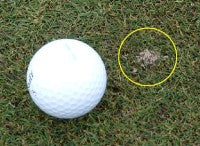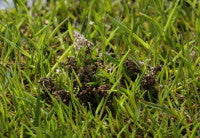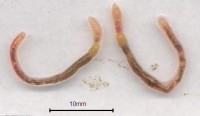YOUR HELP NEEDED
 In the last few years a small, non-native earthworm called Microscolex phosphoreus has started appearing in golf greens and bowling greens across Britain. It deposits small casts on the surface of the sward that can interfere with play. Anecdotal evidence suggests it does not respond to any of the products currently available for controlling earthworms. It is thought to be spreading across the UK, and your help is needed to investigate its distribution.
In the last few years a small, non-native earthworm called Microscolex phosphoreus has started appearing in golf greens and bowling greens across Britain. It deposits small casts on the surface of the sward that can interfere with play. Anecdotal evidence suggests it does not respond to any of the products currently available for controlling earthworms. It is thought to be spreading across the UK, and your help is needed to investigate its distribution.
Microscolex on the move
Microscolex phosphoreus is native to temperate South America. But this species has been spread by man's activities, and it has now been found in parts of North America, Africa, Asia, Australia, New Zealand and continental Europe. It was first recorded in Britain in 1899 from Worcester, followed by two more records in 1913 from Nottingham and Jersey. There were no further reports from Britain for almost one hundred years.
However, in the past five years about twenty new records have been confirmed from golf and bowling greens. These isolated populations are scattered across the country from Cornwall and Kent in the south, up to North Yorkshire. Worryingly, unconfirmed sightings by turf mangers and agronomists suggest that this species may now have arrived in many other locations in Britain. At the moment it is not subject to any official notification, nor is it on the list of quarantine species.
 Microscolex phosphoreus is a small, pale, thread-like worm of length 10 - 35 mm, and width 1.0 - 1.5 mm. Unlike our native species, this earthworm is unusual because it can exude a luminescent fluid at night when disturbed, although it is not always easy to see its greenish glow. It produces small casts on the surface that are about 10 - 15 mm in diameter, up to 10 mm in height, and which detract from the visual quality of the sward. The casts consist of loose sand grains and fine soil particles suggesting the earthworm lives and feeds in the root zone where there is a high sand content. The casts are sometimes clustered close together indicating highly localised patches of infestation.
Microscolex phosphoreus is a small, pale, thread-like worm of length 10 - 35 mm, and width 1.0 - 1.5 mm. Unlike our native species, this earthworm is unusual because it can exude a luminescent fluid at night when disturbed, although it is not always easy to see its greenish glow. It produces small casts on the surface that are about 10 - 15 mm in diameter, up to 10 mm in height, and which detract from the visual quality of the sward. The casts consist of loose sand grains and fine soil particles suggesting the earthworm lives and feeds in the root zone where there is a high sand content. The casts are sometimes clustered close together indicating highly localised patches of infestation.
Native species that cast on the surface tend to do so at night. Therefore, areas affected by deposited casts can be swept clear before the turf is mown prior to play. In contrast, it has been reported that Microscolex phosphoreus can cast throughout the day, causing a continuous problem for play, especially on putting greens. No studies have been carried out on this species in Britain but discussions with some turf managers whose greens are infested suggest that products used to reduce the surface casting of native earthworms have no affect on this invasive species, even when applied at the highest recommended concentrations.
Putting Microscolex on the map
 Now the Natural History Museum and the Turf Disease Centre, sponsored by Syngenta Golf and Landscape, are investigating Microscolex phosphoreus to map its current distribution and to assess how rapidly it may be spreading across the country. You can help by looking out for this species and its small casts on your golf greens and bowling greens. However, these earthworms can only be correctly identified by examining them with a microscope. So, if you think you have this species we would be very grateful if you would send us a small sample of infested turf.
Now the Natural History Museum and the Turf Disease Centre, sponsored by Syngenta Golf and Landscape, are investigating Microscolex phosphoreus to map its current distribution and to assess how rapidly it may be spreading across the country. You can help by looking out for this species and its small casts on your golf greens and bowling greens. However, these earthworms can only be correctly identified by examining them with a microscope. So, if you think you have this species we would be very grateful if you would send us a small sample of infested turf.
These delicate earthworms can be easily injured or killed while trying to remove them from the soil. Therefore, it is better if we extract the earthworms from the turf under laboratory conditions. Their populations may fluctuate with changing weather conditions and you may not see their casts at the time when this article is published. However, please keep looking, and send us turf samples any time over the next twelve months if you find their casts.
If possible, please use a golf hole changer to take the turf sample. Place the hole changer over a piece of turf with one or more casts on the surface. Remove the soil core and with a sharp knife cut the soil core at a depth of 50 -60 mm and send us that top layer with the grass and roots still intact. If you don't have a golf hole changer, send a turf sample of similar surface area as a golf hole.
Please fill in the short questionnaire and return it with your sample. If you send your email address we will confirm whether or not you have Microscolex phosphoreus. All the information you send will only be seen and utilized by the Natural History Museum and The Turf Disease Centre, and will be treated as confidential. We will not disclose specific site locations or contact information to third parties.
A summary of our findings will be published in this magazine and full results will be published in a soil science journal and made available on the web. In all publications the distribution map of Microscolex phosphoreus will be plotted at low resolution to ensure precise locations cannot be determined.
PDF Questionnaire & Address Label
Microscolex Mapping Project Questionnaire
By Dr David T. Jones, earthworm specialist, Natural History Museum, London, and Dr Kate Entwistle, Turfgrass Pathologist, The Turf Disease Centre, Hampshire.
